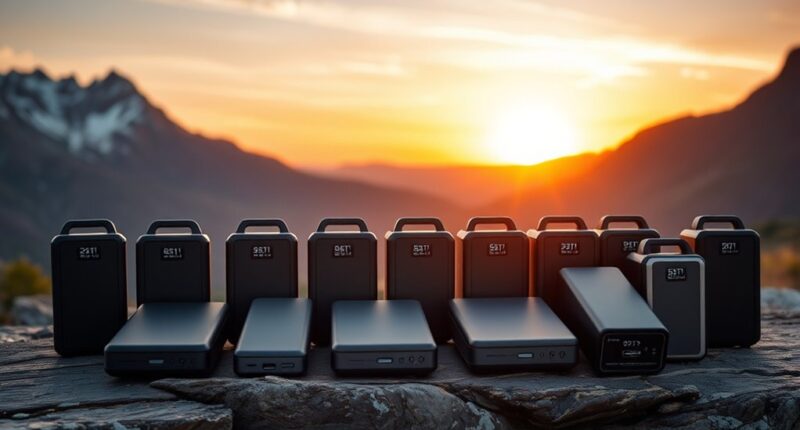If you’re looking for reliable portable power stations in 2025, I’ve found top models like the Jackery Explorer 300 and 1000 v2, Anker SOLIX C300, MARBERO 88Wh, and many others that offer a good mix of capacity, portability, and fast recharging options. They support multiple devices and are perfect for outdoor trips or emergencies. Keep exploring, and you’ll discover the best options to meet your power needs on the go.
Key Takeaways
- Highlights of top portable power stations in 2025, focusing on capacity, portability, and durability.
- Details on design features, size, weight, and ease of transport for on-the-go use.
- Information on battery types, cycle life, and expandability for long-term reliability.
- Overview of charging options, speed, and eco-friendly recharging methods.
- Recommendations for various use cases like camping, emergency backup, and travel.
Jackery Portable Power Station Explorer 300
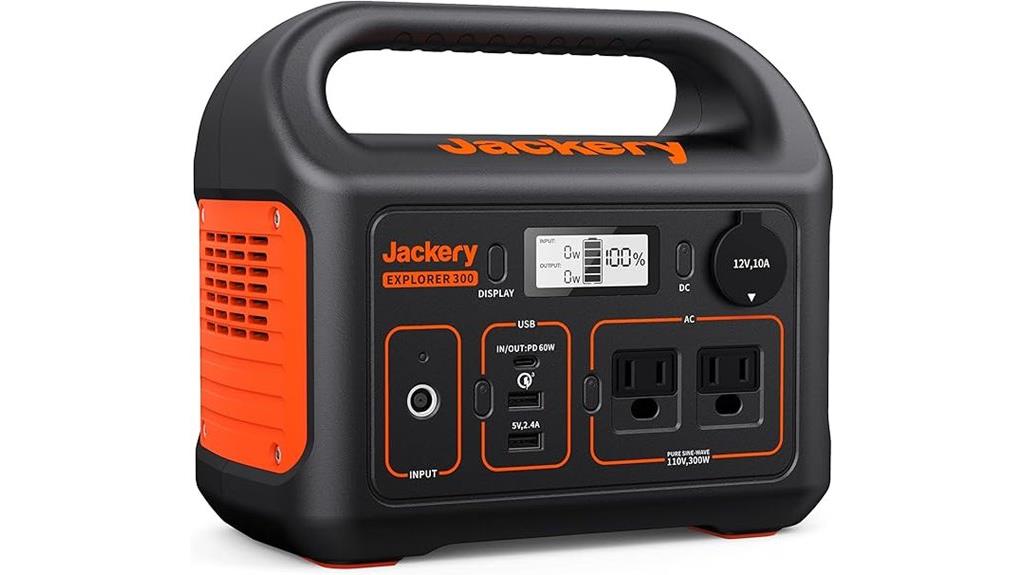
The Jackery Portable Power Station Explorer 300 is an excellent choice for outdoor enthusiasts and emergency preppers who need reliable, lightweight power on the go. Weighing just 7.1 pounds, it’s compact enough for camping, road trips, or backup power. With a 293Wh lithium-ion battery, it can run devices like lights, laptops, and small appliances for hours. Its durable plastic design and sleek black finish make it portable and stylish. Multiple outlets—including AC, USB-C, and DC—allow you to power up to six devices simultaneously. Fast recharging via wall, car, or solar in under 4 hours makes it a versatile solution for off-grid needs.
Best For: outdoor enthusiasts, emergency preppers, and anyone needing portable, reliable power for small devices during camping, road trips, or outages.
Pros:
- Lightweight and compact at just 7.1 pounds, easy to carry and transport
- Multiple outlets including AC, USB-C, and DC, supporting up to six devices simultaneously
- Fast recharging in under 4 hours via wall, car, or solar panels, with pass-through charging capability
Cons:
- Limited to 300W continuous output, may not power high-wattage appliances
- Battery capacity (293Wh) might be insufficient for extended power needs of larger devices
- No built-in Anderson PowerPole connectors, which could be a drawback for ham radio users
Jackery Explorer 1000 v2 Portable Power Station
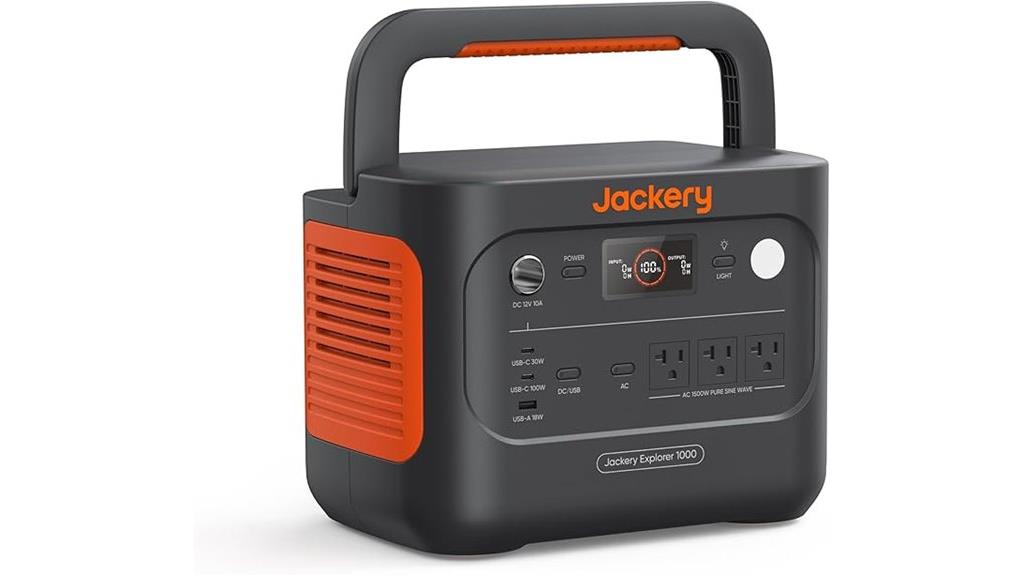
If you’re seeking a reliable and high-capacity portable power station for off-grid adventures or emergency backup, the Jackery Explorer 1000 v2 stands out with its robust 1070Wh LiFePO4 battery and 1500W continuous AC output. It can power multiple appliances simultaneously, including refrigerators, AC units, and electric pots, thanks to three pure sine wave AC ports, USB-C, USB-A, and a DC car port. Weighing just 23.8 pounds with a foldable handle, it’s portable and easy to transport. Fast charging via the Jackery app takes about 1.7 hours, and its long-lasting battery with over 4,000 cycles guarantees reliable performance for years.
Best For: outdoor enthusiasts, emergency preparedness, and off-grid living who need a reliable, high-capacity portable power solution.
Pros:
- High-capacity 1070Wh LiFePO4 battery with over 4,000 charge cycles for long-term use
- 1500W continuous AC output capable of powering multiple appliances simultaneously
- Fast charging in about 1.7 hours via the Jackery app with smart battery management features
Cons:
- App connectivity issues may arise when off-grid, limiting remote control options
- Does not include solar panels, requiring additional purchase for solar charging
- Long charging times from AC power can be inconvenient in urgent situations
Anker Portable Power Station SOLIX C300 (Solar Generator)

For outdoor enthusiasts and emergency preparedness enthusiasts, the Anker SOLIX C300 stands out as an ideal portable power station in 2025 thanks to its compact design and reliable performance. Weighing just over 9 pounds, it’s 15% smaller than similar units, with an integrated handle and impact-resistant build. It offers 288Wh of capacity, powering devices like laptops and small appliances for hours. With multiple AC, USB-C, and USB-A ports, plus solar compatibility, it’s versatile for camping, emergencies, or remote work. Its quiet operation and durable construction ensure dependable power on the go, making it a top choice for those needing portable, sustainable energy.
Best For: outdoor enthusiasts, emergency preparedness users, and remote workers seeking a compact, reliable, and sustainable portable power source.
Pros:
- Lightweight and compact design with an integrated handle for easy portability
- Quiet operation at 25dB, suitable for indoor and outdoor environments
- Versatile charging options including multiple AC, USB-C, and USB-A ports, plus solar compatibility
Cons:
- Limited USB ports, with only two high-wattage USB-C outputs and one USB-A port
- Does not support 5V~3A USB-C panels like PS30, PS200, or PS400
- Slightly heavy for hiking or backpacking, making it less ideal for ultra-lightweight travel
MARBERO Portable Power Station (88Wh) with Solar Charging and AC Outlet
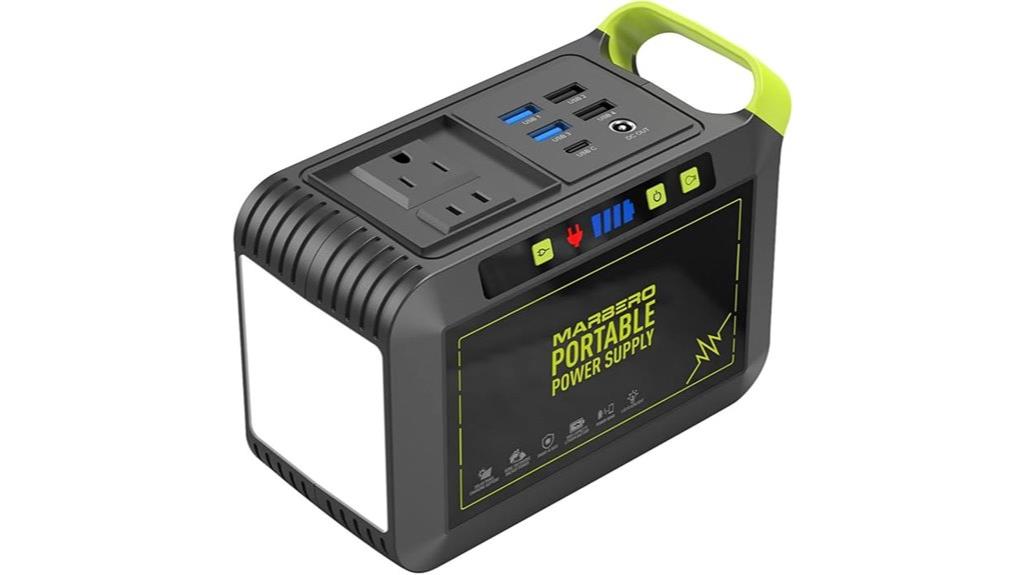
Designed for outdoor enthusiasts and emergency preparedness, the MARBERO Portable Power Station (88Wh) delivers reliable, versatile power in a compact package. Weighing just 3.2 pounds and measuring 6.5 x 4.6 x 3.1 inches, it’s easy to carry for camping, road trips, or backup power at home. It features fast charging—reaching 80% in 2 hours—and supports simultaneous device charging through multiple outputs, including AC, USB, and DC ports. Compatible with solar panels, it offers eco-friendly recharging options. The built-in flashlight, safety features, and durable design make it a dependable choice for off-grid adventures and emergencies alike.
Best For: outdoor enthusiasts, campers, and emergency preppers seeking a portable, versatile power solution for off-grid and backup power needs.
Pros:
- Compact, lightweight design weighing only 3.2 lbs for easy portability
- Fast charging capability reaching 80% in just 2 hours with included adapter
- Multiple output options including AC, USB, USB-C PD, and DC, supporting various devices simultaneously
Cons:
- Limited capacity of 88Wh may not be sufficient for high-power or prolonged usage
- Only two AC outlets, which might restrict powering multiple larger appliances at once
- Requires compatible solar panels for eco-friendly recharging, adding extra equipment and cost
Portable Power Station 600W 293Wh for Camping and Emergency Backup
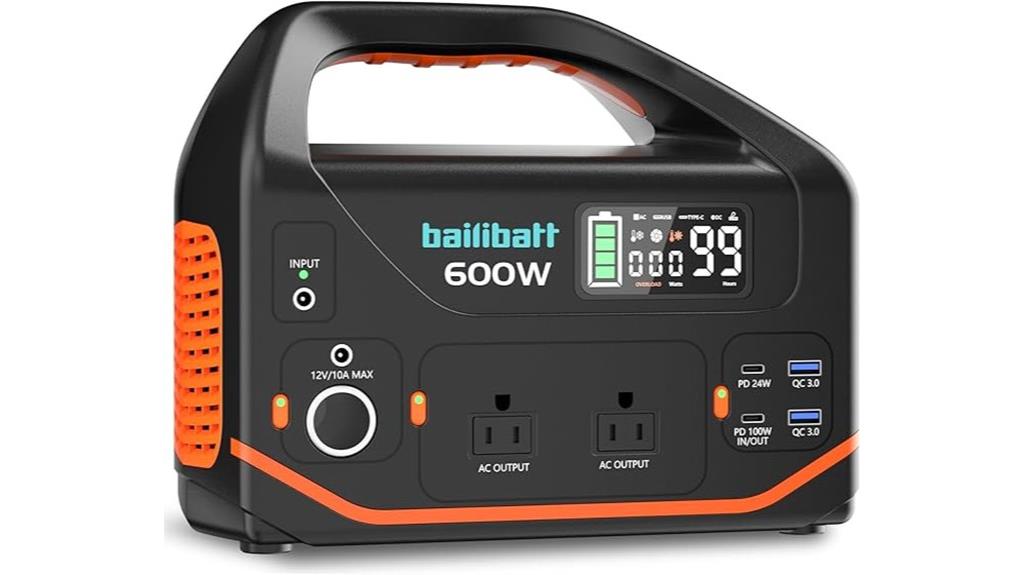
The Portable Power Station 600W 293Wh is an excellent choice for campers and emergency preparedness, thanks to its lightweight design and versatile charging options. Weighing just 7.7 pounds, it’s easy to carry and fits comfortably in any gear setup. With a 600W pure sine wave AC output and multiple ports—including USB-C, USB-A, car, and DC—it can power laptops, small appliances, and electronics simultaneously. Its built-in LCD display keeps you updated on battery life and power consumption. Supporting solar, AC, and car charging, this station offers reliable, safe power wherever you need it, making it perfect for off-grid adventures or backup during outages.
Best For: outdoor enthusiasts, campers, and emergency preparedness individuals seeking portable, reliable power for multiple devices in off-grid or backup scenarios.
Pros:
- Lightweight and compact design weighing only 7.7 pounds for easy portability.
- Multiple charging ports including USB-C, USB-A, car, and DC for versatile device compatibility.
- Supports solar, AC, and car charging options for flexible power sources.
Cons:
- Some users have reported initial charging issues or device power failures after initial use.
- Limited to powering devices under 600W, which may not suit high-power appliances.
- Battery life may require careful management with frequent recharging for long-term use.
Portable Solar Generator with Foldable Solar Panel 300W
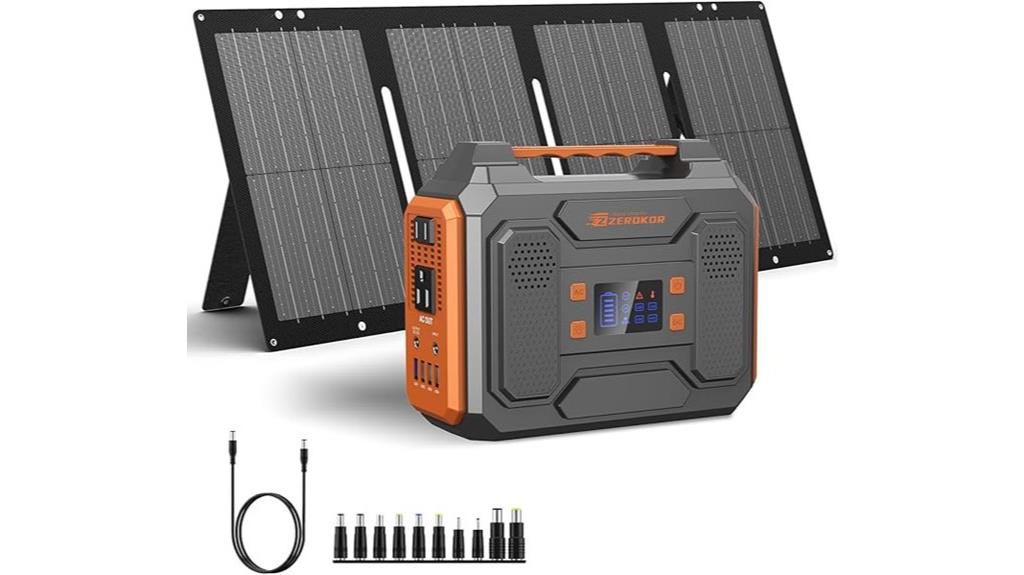
If you’re seeking reliable off-grid power with eco-friendly recharging options, the ZeroKor 300W Portable Solar Generator is an excellent choice. It combines a 280Wh lithium-ion battery with a high-efficiency 60W foldable monocrystalline solar panel, offering a conversion rate of 20.5%. Weighing just over 5 pounds, it’s perfect for camping, RV trips, or emergencies. It provides multiple outlets, including AC, USB, and DC ports, supporting devices up to 300W. Recharging options include solar, wall AC, or car adapter, making it versatile for various situations. Its compact design and eco-friendly power make it a practical solution for reliable, portable energy.
Best For: outdoor enthusiasts, campers, and emergency preparedness individuals seeking portable, eco-friendly power solutions.
Pros:
- Lightweight and compact design weighing just over 5 pounds for easy portability
- High conversion efficiency (20.5%) of the foldable solar panel for effective recharging in low-light conditions
- Multiple output options (AC, USB, DC) support a wide range of small devices and appliances
Cons:
- Limited to devices under 300W; unsuitable for high-power appliances or heavy-duty equipment
- Not waterproof; solar panel junction box requires protection from moisture during outdoor use
- Battery capacity (280Wh) may not be sufficient for extended power needs without frequent recharging
Anker SOLIX C1000 Portable Power Station (Optional Solar Panel)

For anyone seeking reliable, fast-charging portable power with long-term durability, the Anker SOLIX C1000 stands out as an excellent choice. It packs a hefty 1056Wh LiFePO4 battery and delivers 1800W continuous power, with peak output reaching 2400W. Thanks to UltraFast recharging technology, it can reach 80% in just 43 minutes and fully recharge in under an hour via AC. Solar recharging adds flexibility, powering the unit in 1.8 hours with up to 600W. Built for longevity, it offers 3,000 battery cycles over ten years, making it perfect for outdoor adventures, home backup, or emergencies.
Best For: outdoor enthusiasts, emergency preparedness, and homeowners seeking reliable, fast-charging portable power with long-lasting durability.
Pros:
- High-capacity 1056Wh LiFePO4 battery ensures long-term, reliable power for various devices
- Fast UltraFast recharging technology allows 80% charge in 43 minutes and full recharge in under an hour
- Supports sustainable energy use with solar recharging up to 600W, making it eco-friendly and versatile
Cons:
- Slightly larger size compared to some compact units, which may affect portability for some users
- Higher initial investment due to advanced features and durable design
- Requires compatible solar panel and accessories for optimal solar recharging setup
EF ECOFLOW Portable Power Station DELTA 2, 1024Wh LiFePO4 Battery
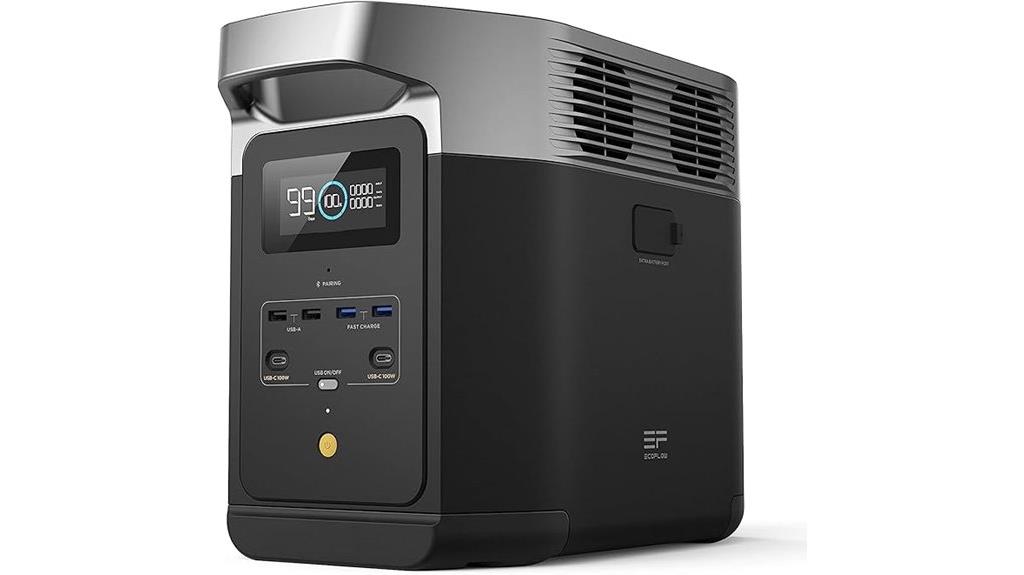
With its impressive 1024Wh LiFePO4 battery capacity and expandable design, the EF ECOFLOW DELTA 2 stands out as an ideal choice for outdoor enthusiasts and emergency preparedness. It can be expanded from 1kWh to 3kWh by adding extra batteries, supporting a wide range of appliances, including household devices. Its rapid charging capabilities—80% in just 50 minutes—make recharging quick and easy, especially with solar input up to 500W. With 1800W continuous power and 15 outlets, it reliably powers everything from laptops to small appliances. Built with durable LiFePO4 chemistry, it offers over 3000 cycles, ensuring long-term safety and performance.
Best For: outdoor enthusiasts, RV owners, and emergency preparedness individuals seeking reliable, portable power with fast recharge and expandability.
Pros:
- Rapid charging capabilities: 0-80% in just 50 minutes, convenient for quick recharges
- Large 1024Wh LiFePO4 battery with over 3000 cycles ensures longevity and safety
- Expandable from 1kWh to 3kWh, flexible for various power needs and appliances
Cons:
- Requires additional batteries for maximum capacity, increasing overall cost
- Might be heavy and bulky for portable use without proper handling equipment
- Limited to 500W solar input, which may slow down recharging in low sunlight conditions
EnginStar Portable Power Station 300W (296Wh) Battery Bank

The EnginStar Portable Power Station 300W stands out as an ideal choice for outdoor enthusiasts and emergency preparedness, thanks to its compact design and versatile charging options. Weighing just 6.5 pounds and measuring 9 x 5.5 x 7.5 inches, it’s easy to carry anywhere. It offers 300W continuous AC power through two pure sine wave outlets, perfect for sensitive electronics. With a 296Wh battery, it supports multiple device types via USB, USB-C, and regulated DC ports. You can recharge it using solar, wall outlet, or car socket, making it a flexible, reliable power source for camping, travel, or emergencies.
Best For: outdoor enthusiasts, campers, and emergency preppers seeking a portable, reliable power source for their electronic devices.
Pros:
- Compact and lightweight design (6.5 pounds, 9 x 5.5 x 7.5 inches) for easy portability.
- Multiple charging options including solar, wall outlet, and car socket for versatile recharging.
- Pure sine wave AC outlets provide stable, quiet power suitable for sensitive electronics.
Cons:
- Limited 300W continuous power may not support high-wattage appliances.
- Solar panel not included, requiring additional purchase for solar charging.
- Battery capacity of 296Wh may be insufficient for extended power needs without recharging.
Anker 521 Portable Power Station (256Wh)
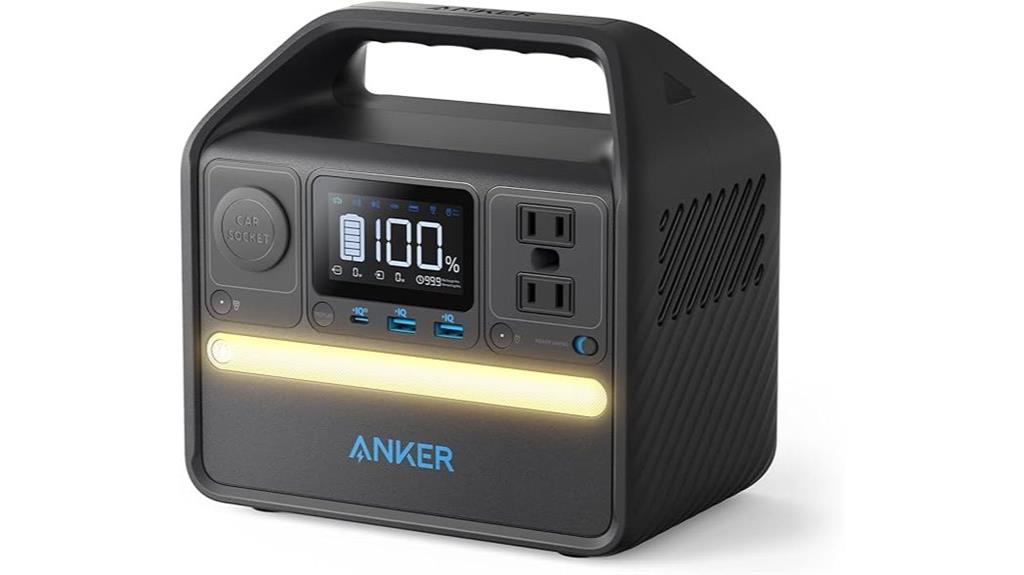
If you’re looking for a reliable portable power solution that can handle multiple devices during outdoor adventures or power outages, the Anker 521 Portable Power Station (256Wh) stands out. Its 256Wh capacity offers ample energy to keep your devices running longer, while SurgePower technology provides up to 600W output for high-demand appliances. With upgraded LiFePO4 batteries, it promises a decade-long lifespan, ensuring long-term reliability. It features six versatile ports, including AC, USB-A, USB-C, and a car outlet, supporting fast charging and recharging options. Plus, it comes with a five-year warranty and friendly customer service, making it a dependable choice for on-the-go power needs.
Best For: outdoor enthusiasts, campers, and homeowners seeking a durable, versatile portable power solution for long-lasting device support during outages or adventures.
Pros:
- 256Wh capacity provides extended energy supply for multiple devices
- SurgePower technology supports high-demand appliances up to 600W
- Upgraded LiFePO4 batteries ensure a long lifespan of up to 10 years
Cons:
- May be heavier and bulkier compared to smaller portable chargers
- Limited to 600W peak output, not suitable for very high-power appliances
- The initial cost could be higher than basic portable power banks
PROGENY 300W Portable Power Station (299Wh/80818mAh)

For outdoor enthusiasts and travelers seeking reliable power on the go, the PROGENY 300W Portable Power Station stands out with its lightweight design and versatile charging options. Weighing just 7 pounds, it offers 299Wh capacity, enough to charge smartphones 40 times or run a mini fridge for hours. It features multiple outputs, including a pure sine wave 110V outlet, USB-C, QC 3.0 USB, and a regulated 12V port for stable power. With fast recharging via solar, car, or wall outlet, plus built-in safety features like BMS, it’s a dependable, compact solution for camping, travel, or emergency use.
Best For: outdoor enthusiasts, travelers, and emergency preparedness individuals needing reliable, portable power sources for devices and small appliances.
Pros:
- Lightweight and portable at only 7 pounds for easy carrying.
- Versatile charging options including solar, car, and wall outlet for flexible recharging.
- Safe and stable power delivery with pure sine wave output and built-in BMS protection.
Cons:
- Limited to 299Wh capacity, which may not power larger appliances for extended periods.
- Charging times via solar, car, or wall outlet can take several hours (6-8 hours).
- Only one AC outlet may restrict simultaneous device charging needs.
Portable Power Station 99.9Wh Power Bank
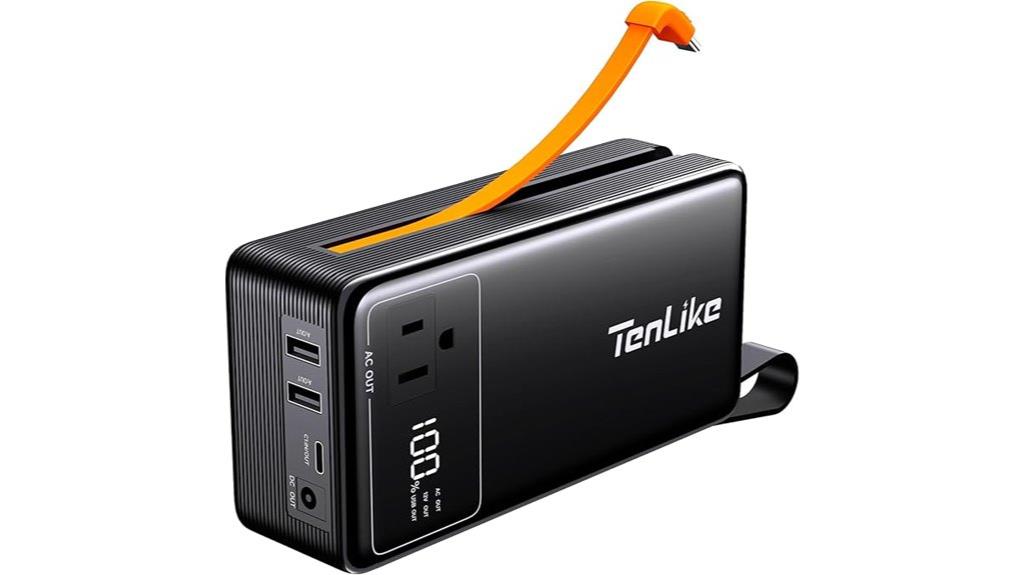
A 99.9Wh portable power bank offers the perfect balance of high capacity and compact size, making it ideal for outdoor enthusiasts and travelers who need reliable power on the go. Its airline-allowed maximum capacity, combined with a small footprint measuring just 6.5 x 3.2 x 1.9 inches, guarantees portability without sacrificing performance. Weighing only 1.65 pounds, it’s easy to carry in backpacks or luggage. Equipped with six versatile ports—including AC, USB-C, and Type-C—it can power phones, laptops, small appliances, and more. Its fast recharging, durable lithium-ion battery, and safety features make it a dependable choice for camping, emergencies, or everyday backup.
Best For: outdoor adventurers, travelers, and anyone needing reliable portable power for camping, emergencies, or daily backup.
Pros:
- Compact, lightweight design (1.65 pounds, 6.5 x 3.2 x 1.9 inches) for easy portability
- Multiple versatile ports including AC, USB-C, and Type-C for powering various devices simultaneously
- Fast recharging options via AC, solar, or Type-C, with high-capacity battery and safety features
Cons:
- Limited 99.9Wh capacity may not support large appliances or high-power devices for extended periods
- No built-in wheels or extended handle for easier mobility over longer distances
- Some users may find it less suitable for heavy-duty or high-energy-demand equipment
Portable Power Station 600W with Battery Backup and Solar Option
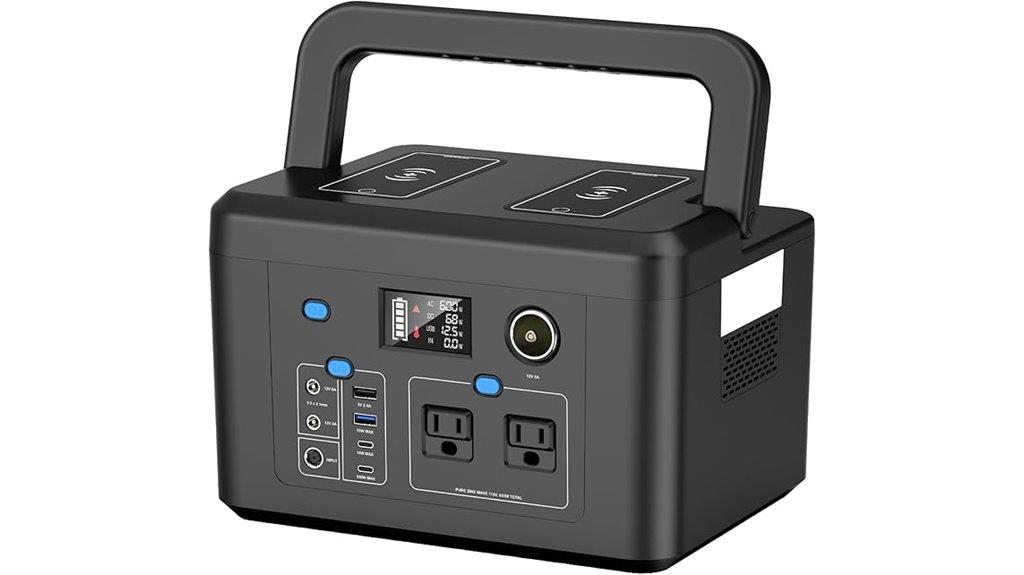
The Portable Power Station 600W with Battery Backup and Solar Option stands out as an ideal solution for outdoor enthusiasts and emergency preparedness, thanks to its versatile charging options and lightweight design. Weighing just 9.9 pounds, it packs a 296Wh lithium-ion battery capable of powering devices under 600W. It features dual AC outlets, USB ports, wireless chargers, and DC outputs, supporting both battery and solar input—ideal for camping, RV use, or backup power during outages. Its compact build, digital display, and protection features make it user-friendly, while solar compatibility allows eco-friendly recharging. Overall, it’s a reliable, portable power source for various on-the-go needs.
Best For: outdoor enthusiasts, emergency preparedness users, and small device users seeking portable, eco-friendly power solutions.
Pros:
- Lightweight and compact design weighing only 9.9 pounds for easy portability.
- Multiple charging options including AC, USB, wireless, and solar inputs for versatile use.
- Provides clean pure sine wave AC output, protecting sensitive electronics during power outages or outdoor activities.
Cons:
- Limited power capacity (296Wh) may not support high-wattage devices or extended use for larger appliances.
- Some users report longer recharge times and potential issues with solar compatibility or battery longevity over time.
- Charging and device compatibility issues have been noted, possibly affecting reliability in certain situations.
Portable Power Station, 266Wh Lithium Battery Generator for Camping and Home Use
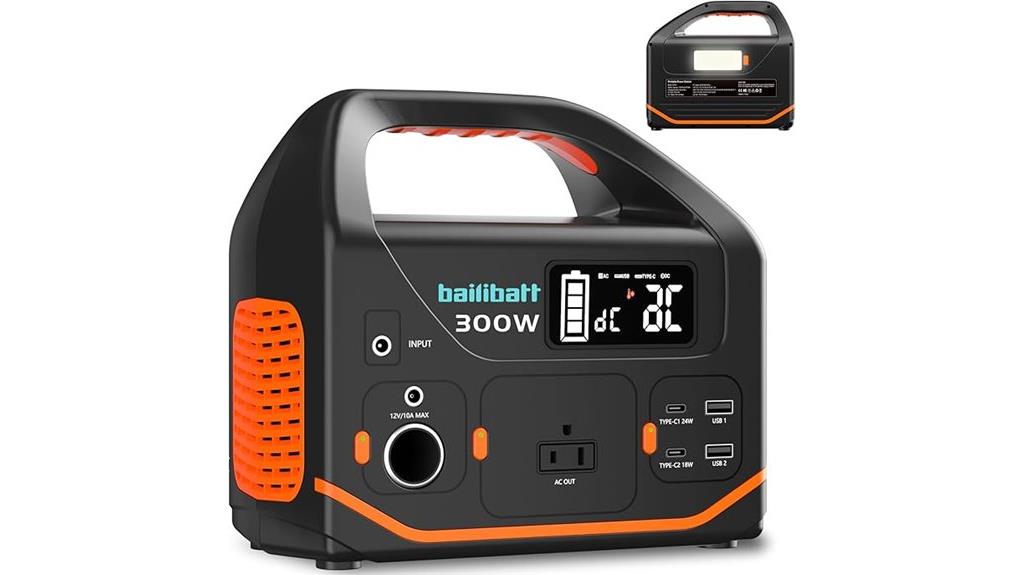
If you’re searching for a reliable, portable power solution that can handle both outdoor adventures and emergency needs, the 266Wh lithium battery generator from bailibatt is an excellent choice. With its 72,000mAh capacity, it provides fast, safe, and dependable power for camping, home backup, or RV trips. Its compact, lightweight design makes it easy to carry and durable enough for various indoor and outdoor uses. The unit features seven output ports, including a 300W pure sine wave AC outlet, USB-C, QC USB, and a car port, supporting a maximum load of 300W. It also includes a built-in LED flashlight and an LCD display for real-time status updates.
Best For: outdoor enthusiasts, campers, and homeowners seeking a reliable portable power source for emergencies and off-grid activities.
Pros:
- Compact and lightweight design for easy portability and outdoor use
- Multiple output ports including AC, USB-C, and car port for versatile device charging
- Built-in LED flashlight and LCD display for convenient emergency use and real-time status monitoring
Cons:
- Limited maximum load of 300W may not power larger appliances
- Recharging relies solely on AC adapter, lacking solar or alternative charging options
- Battery capacity may be insufficient for extended power needs in high-demand situations
Portable Power Station 300W (600W Peak), 220Wh Solar Power Bank with 2 AC Outlets
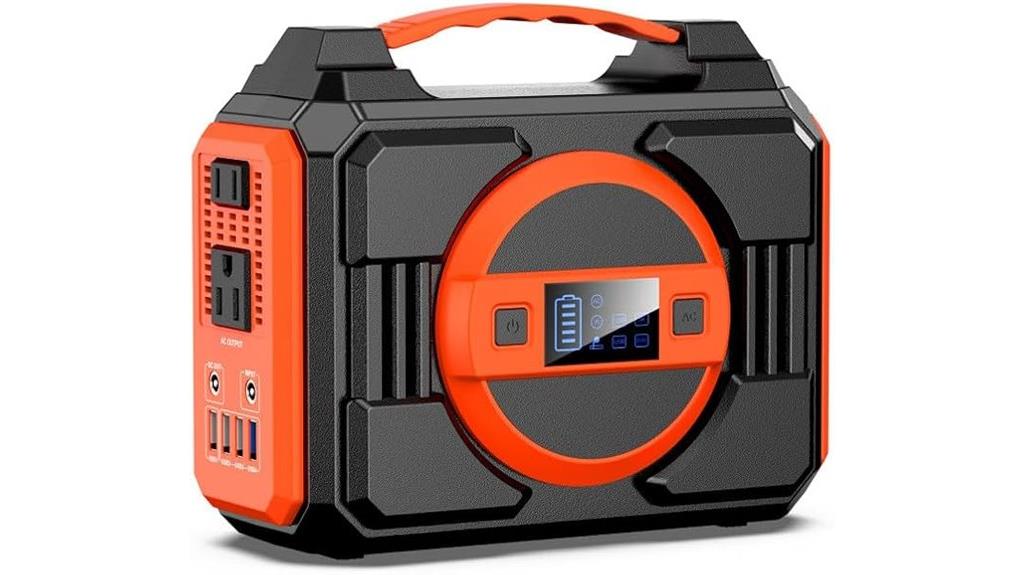
For outdoor enthusiasts and emergency preparedness, the Portable Power Station 300W (600W Peak), 220Wh Solar Power Bank stands out with its compact size and versatile charging options. Weighing only 5 pounds and measuring 8.5 x 6.7 x 4.1 inches, it’s easy to carry anywhere. It can charge up to seven devices simultaneously, including phones, laptops, and small appliances, thanks to its two AC outlets and multiple USB ports. With options to recharge via wall, car, or solar, it offers flexibility in any setting. Its bright LED light adds safety during dark situations. Overall, it’s a reliable, portable power solution for a variety of outdoor and emergency needs.
Best For: outdoor enthusiasts, campers, and emergency preppers seeking a compact, versatile power source for multiple devices in various settings.
Pros:
- Lightweight and portable design weighing only 5 lbs for easy transportation
- Supports up to 7 devices simultaneously with multiple output options including AC, USB, and DC ports
- Multiple recharging methods (wall, car, solar) provide flexibility and convenience
Cons:
- Solar charging efficiency may vary and can be slower than other methods
- Limited battery capacity (220Wh) may not power larger appliances for extended periods
- Recharging speed can be slow depending on power source and device compatibility
Factors to Consider When Choosing Portable Power Stations
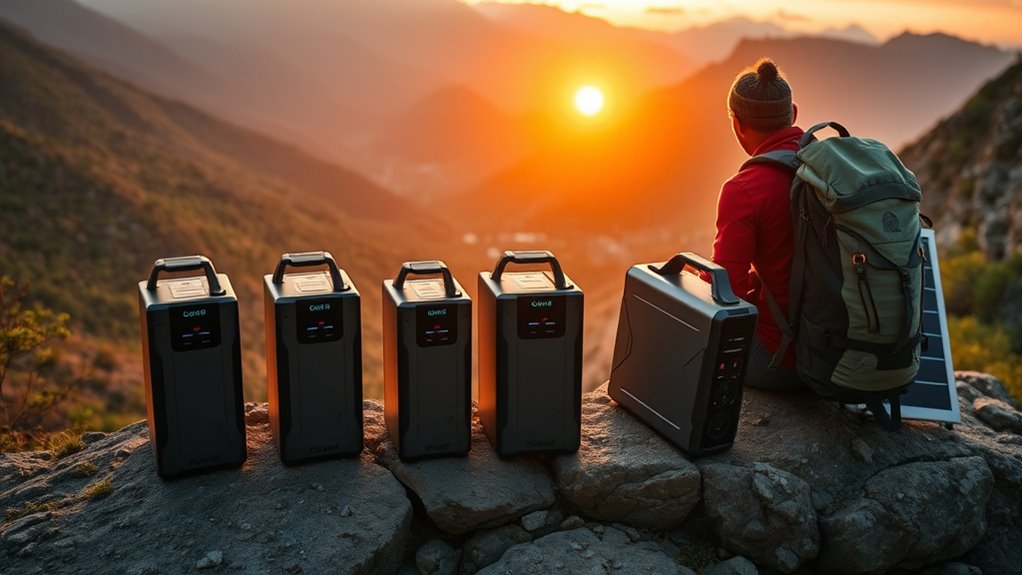
When choosing a portable power station, I focus on my power capacity needs and how many devices I want to run simultaneously. I also consider the available recharging options and how portable the unit is for my activities. Finally, I think about battery lifespan and size to make sure it fits my long-term and travel requirements.
Power Capacity Needs
Choosing the right portable power station hinges on accurately evaluating your power capacity needs. I start by calculating the total wattage of all devices I plan to run simultaneously, ensuring the station’s continuous and surge ratings can handle that load. I also match the battery capacity, measured in Wh or Ah, to how long I need my devices to operate, considering their individual power consumption. For extended use, I opt for higher-capacity units, like 1000Wh or more, to support multiple devices over longer periods. I also consider the electronics I’ll power—sensitive equipment may require pure sine wave inverters for stable output. Ultimately, I balance capacity with portability and budget, since larger units tend to be heavier and pricier.
Port Selection Options
Selecting the right port options on a portable power station is essential for ensuring compatibility and convenience. Multiple ports like AC outlets, USB-C, USB-A, and DC car ports let me power a variety of devices simultaneously. The number of ports and their wattage ratings determine how many gadgets I can run at once and if high-wattage appliances are supported. Pure sine wave outlets are indispensable for sensitive electronics, providing stable, clean power. Some stations feature fast-charging USB-C ports and extra AC outlets, reducing charging times and boosting convenience. Additionally, the placement and accessibility of ports matter, especially when managing multiple devices outdoors or during emergencies. Well-designed port options make a portable power station more versatile and user-friendly in any situation.
Recharging Methods Flexibility
To make certain I can keep my devices powered in any situation, I look for a portable power station that offers multiple recharging options like wall outlets, solar panels, and vehicle adapters. This versatility ensures I can recharge whether I’m indoors, off-grid, or on the road. Solar recharge times vary based on panel wattage and sunlight—ranging from about 1.5 hours with high-wattage panels to over 4 hours with less powerful ones. MPPT technology enhances efficiency by optimizing energy harvest. Flow-through charging is also essential, allowing me to operate devices while recharging the station simultaneously during extended outages or outdoor adventures. The ability to recharge quickly and through different methods makes a power station more practical and reliable in diverse scenarios.
Battery Longevity Expectations
When evaluating portable power stations, understanding battery longevity is essential because it directly affects how long your device will serve you before needing a replacement. Most lithium-ion batteries offer between 500 and 2,000 charge cycles, with capacity decreasing markedly afterward. In contrast, Lithium Iron Phosphate (LiFePO4) batteries provide over 3,000 cycles, lasting 8-10 years under normal use. Proper maintenance, like avoiding full discharges and storing the unit in a cool, dry place, can extend battery life. Manufacturers usually specify the expected number of charge cycles, after which capacity drops to around 70-80%, reducing runtime. Managing recharging habits—avoiding deep discharges and staying within recommended voltages—can maximize your power station’s lifespan and ensure reliable performance over time.
Size and Portability
Size and portability are essential factors because they determine how easily you can carry and store your portable power station. The size, measured in inches, affects how well it fits into your backpack, car, or storage space. Lighter models under 10 pounds are perfect for hiking or frequent travel, while heavier units often provide higher capacity. Compact designs with built-in handles or straps make transport effortless, especially during outdoor activities. Keep in mind, smaller units usually have fewer ports to keep weight down, so you’ll need to balance size with your power needs. Choosing the right size means finding a device that’s easy to carry but still capable of delivering enough power for your devices. It’s all about balancing portability with performance.
Device Compatibility
Choosing a portable power station that matches your devices’ needs is essential to guarantee reliable performance. You should verify it has the right output ports and wattage ratings to handle your electronics, like USB-C PD, AC outlets, or DC car ports. Check if your devices’ voltage and plug types are compatible, especially for sensitive gear like laptops, cameras, or medical devices. Also, confirm if the power station supports your devices’ charging standards, such as fast-charging USB-C protocols or surge capacity requirements. Consider the battery chemistry—Li-ion or LiFePO4—to match your device’s longevity and safety needs. Finally, see if it supports pass-through charging for continuous power during recharging, ensuring your devices stay powered without interruption.
Safety and Protection Features
Ensuring your portable power station has robust safety and protection features is crucial for reliable and secure operation. I look for built-in Battery Management Systems (BMS) that monitor voltage, current, and temperature to prevent overcharging, overheating, or short circuits. Surge protection is also essential to handle sudden power spikes without damaging your devices. I verify that the station includes overload protection, over-voltage cutoff, and automatic shutoff to safeguard both the power station and connected electronics. Durability matters, so I prefer models with impact-resistant enclosures and effective cooling systems to maintain safe temperatures during extended use. Finally, I check for compliance with safety standards like UL and FCC, ensuring the device meets established safety and quality benchmarks for peace of mind.
Budget and Cost
When selecting a portable power station, budget plays a significant role in narrowing down your options. Prices range from around $100 for basic models to over $1,500 for high-capacity units, so it’s essential to assess your needs first. Investing a bit more often means better battery life, more ports, and faster recharging, which adds value over time. Don’t forget to factor in extra accessories like solar panels or extension cords—they can boost functionality but increase costs. Cheaper models typically have limited capacity (under 200Wh) and fewer outputs, possibly requiring multiple units for larger power needs. Striking the right balance between your budget and required features helps guarantee you get reliable performance without overspending on unnecessary features.
Frequently Asked Questions
How Long Do Portable Power Stations Typically Last on a Single Charge?
Portable power stations usually last anywhere from 4 to 24 hours on a single charge, depending on their capacity and what you’re powering. I’ve found that smaller models are perfect for quick trips or charging devices, while larger ones can keep multiple appliances running longer. To maximize their lifespan, I always manage my usage wisely and keep the stations fully charged when not in use.
Can Portable Power Stations Be Used to Power Sensitive Electronic Devices?
Absolutely, portable power stations can power sensitive electronics, but with caution. Think of them as gentle giants—powerful yet delicate. I always check the wattage and guarantee the station provides clean, stable power, especially for delicate devices like laptops and cameras. Using models with pure sine wave inverters helps prevent surges that could damage electronics. When chosen wisely, they’re a reliable, portable solution for safeguarding your sensitive gear on the go.
Are Portable Power Stations Safe to Use Indoors or in Small Spaces?
Yes, portable power stations are generally safe to use indoors or in small spaces if you follow the manufacturer’s safety guidelines. I always guarantee proper ventilation and keep the unit away from water or flammable materials. It’s important to use the right connections and avoid overloading them. When used correctly, they provide reliable power without risking safety, making them a convenient option for indoor use.
How Effective Are Solar Panels in Charging Portable Power Stations During Cloudy Days?
Solar panels on cloudy days are surprisingly effective, almost like magic! I’ve seen them generate enough power even when the sky is gray, making me believe they’re a superhero for outdoor adventures. While they might not match full sun’s efficiency, they still recharge my portable power station enough to keep my gadgets running. It’s impressive how technology maximizes weak sunlight, turning gloomy skies into a reliable power source.
What Is the Typical Lifespan and Warranty Period for Portable Power Stations?
A typical portable power station lasts around 2 to 5 years, depending on usage and maintenance. Most come with a warranty of 1 to 3 years, offering peace of mind. I always recommend checking the manufacturer’s warranty details, as some brands provide extended coverage. Proper care, like avoiding overcharging and keeping it in a cool, dry place, can considerably extend its lifespan and keep it functioning reliably for years.
Conclusion
Choosing the right portable power station is like finding a trusty sidekick for your adventures—reliable, versatile, and ready when you need it most. Whether you need a compact option or a powerful backup, there’s a station on this list for you. Just remember, the best one matches your needs as perfectly as a key fits a lock. Stay powered up and enjoy your adventures with confidence!
